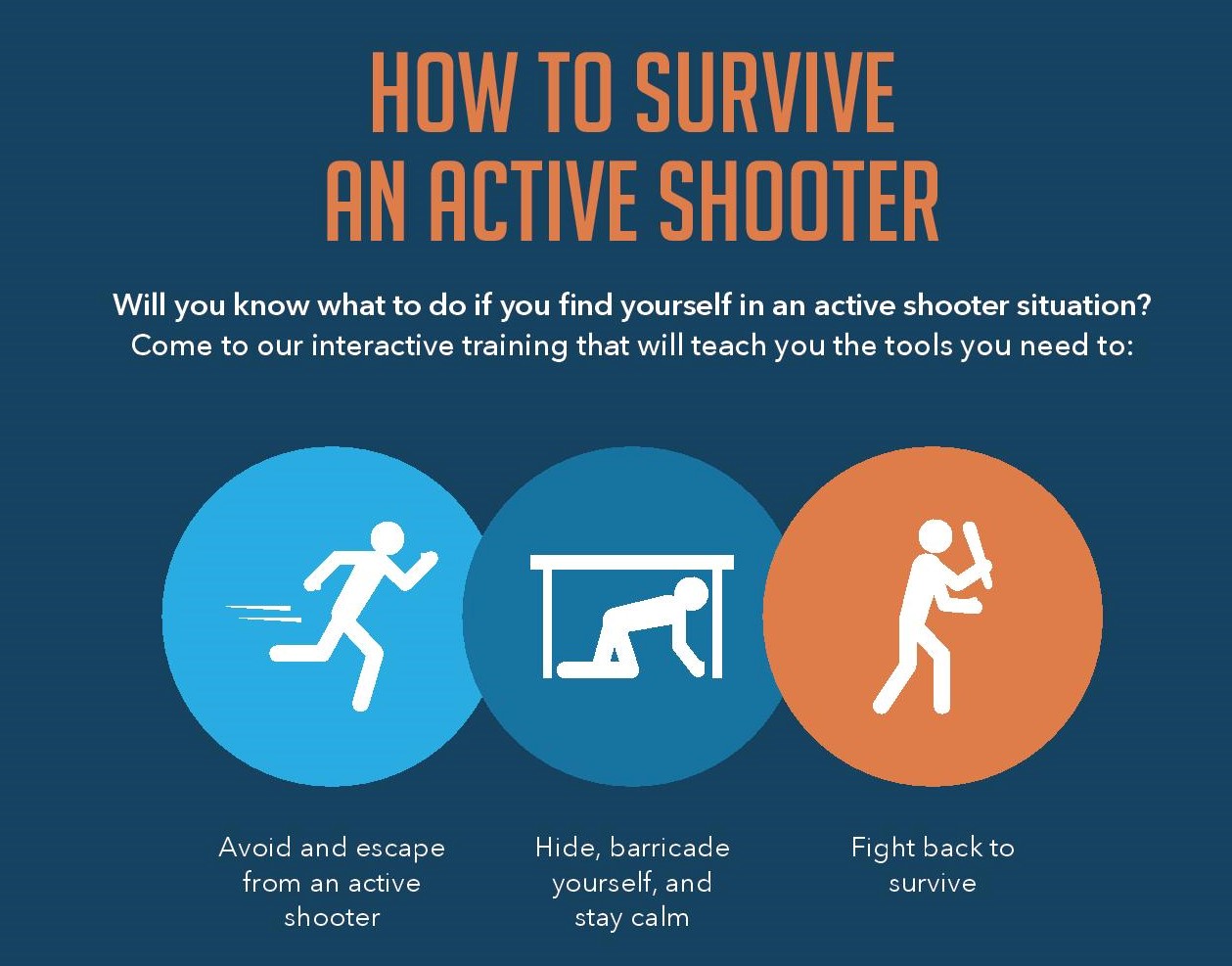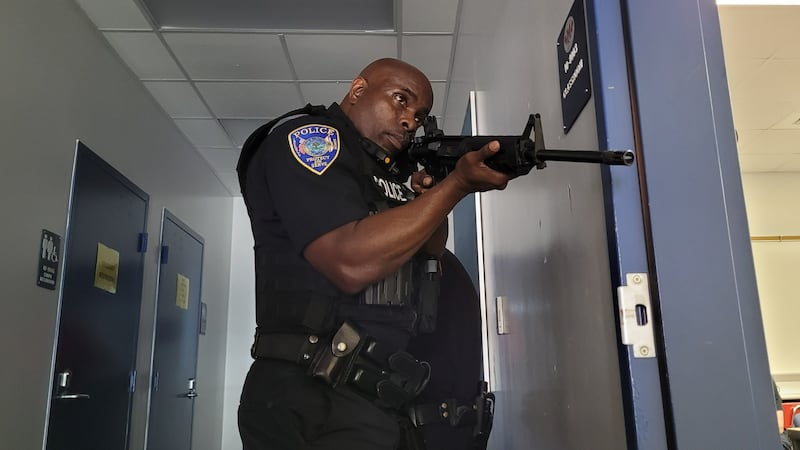Best Practices for Applying Active Shooter Training in Your Firm
Best Practices for Applying Active Shooter Training in Your Firm
Blog Article
Carrying Out Energetic Shooter Training: Ideal Practices for Developing a Safe and Prepared Neighborhood Setting
As areas face the upsetting fact of active shooter occurrences, the implementation of extensive training programs ends up being crucial. An effective technique depends upon not only the development of tailored curricula that deal with neighborhood risks but also the involvement of diverse stakeholders. By employing a range of training techniques, neighborhoods can make sure that all participants are furnished with necessary abilities. The challenge exists in preserving an adaptive structure that progresses with emerging hazards. What are the crucial aspects that can change a conventional training program right into a robust model for community resilience?

Comprehending the Need for Educating
In an era marked by boosting cases of physical violence in public spaces, comprehending the requirement for energetic shooter training has actually never been a lot more critical. Thorough training campaigns can furnish participants with the knowledge and skills to react decisively.
Training promotes a feeling of empowerment and readiness, making it possible for individuals to really feel more protected in their surroundings. The advantages of energetic shooter training expand past immediate response; they consist of enhancing communication methods and enhancing general safety actions within companies.
Secret Components of Effective Programs
Reliable energetic shooter training programs incorporate several vital parts that improve readiness and action capabilities. Initially, detailed educational program development is vital, making sure that training content is pertinent, evidence-based, and customized to the particular needs of the organization or community. This consists of recognizing the characteristics of energetic shooter events and the emotional influence on people entailed.
Second, realistic training situations need to be employed to replicate potential scenarios, allowing participants to exercise decision-making and feedback techniques in a regulated atmosphere. These drills promote muscle memory and develop self-confidence amongst participants.
Third, a concentrate on interaction protocols is critical. Establishing clear lines of communication among regulation enforcement, emergency responders, and participants makes sure worked with actions during an occurrence. Normal updates and refresher course courses assist maintain interaction paths clear and effective.
Fourth, ongoing assessment and responses systems should be integrated into the training program - active shooter training. Examining the effectiveness of training through participant feedback and performance metrics permits continual improvement
Finally, promoting a culture of security and preparedness within the community motivates caution and positive procedures, making certain that people are not only qualified however also participated in maintaining a secure environment.
Engaging Community Stakeholders

To efficiently involve these stakeholders, it is necessary to communicate the goals and benefits of the training. Organizing informational sessions can aid clarify the training's objective, address problems, and lay out the roles each stakeholder might play. Developing a stakeholder advisory board can facilitate continuous dialogue, allowing for diverse viewpoints and insights to be integrated into the training program.
Building partnerships with area leaders and organizations is likewise crucial. Their assistance can boost outreach efforts, boost engagement, and ensure that training is tailored to the distinct requirements of the community. Furthermore, stakeholders can aid in sharing info and resources, strengthening the message of security and readiness.
Inevitably, involving community stakeholders not only enhances the training campaign however also grows a sense of ownership among citizens, bring about a more resistant and educated neighborhood qualified of responding effectively to potential dangers.
Educating Shipment Techniques
Making use of a range of training shipment methods is vital to fit the varied knowing styles and needs of individuals in active shooter training programs (active shooter training). Reliable training can take several image source kinds, including lectures, hands-on simulations, on-line modules, and interactive workshops. Each method serves an unique function and can enhance the total knowing experience

On the internet components offer adaptability and accessibility, allowing individuals to learn at their own speed. These can include video clips, tests, and conversations to determine understanding. Interactive workshops encourage seminar and problem-solving, advertising team effort and interaction skills.
Including a combined method that integrates these approaches not only enriches the training experience but additionally makes certain that participants are better prepared to respond effectively in the occasion of an energetic shooter situation (active shooter training). By dealing with different learning preferences, companies can develop a more educated and responsive community
Constant Analysis and Renovation
Regular evaluation and improvement of energetic shooter training programs are important to keeping their relevance and performance. As threats develop, so need to the strategies and methods used in training. Continual evaluation makes certain that training web content reflects the newest knowledge on energetic shooter occurrences, incorporating lessons gained from current events and adjusting for arising fads.
To facilitate this procedure, organizations need to establish responses systems that consist of individual analyses, specialist reviews, and incident debriefs. Gathering data on individual efficiency throughout drills and exercises is necessary, as it highlights locations needing improvement and informs future training sessions. Additionally, involving with police and emergency situation -responders can offer important understandings right into the usefulness and applicability of training methods.
Consistently arranged reviews of training materials and strategies must be mandated, cultivating a setting of innovation and adaptability. click here now Organizations must likewise encourage a culture of recurring discovering, where employee feel encouraged to suggest changes based upon their experiences. By devoting browse around here to continuous analysis and improvement, companies not just improve the performance of their energetic shooter training programs but also enhance their overall commitment to security and readiness within the neighborhood.
Verdict
To conclude, reliable implementation of active shooter training requires a detailed method that focuses on neighborhood engagement and sensible simulations. By creating tailored educational programs, integrating varied training methods, and cultivating partnership amongst stakeholders, communities can enhance readiness. Continuous assessment and feedback mechanisms are vital for adapting programs to arising hazards, therefore enhancing total security. Ultimately, a dedication to continuous training and improvement grows a culture of vigilance and readiness, guaranteeing a much safer setting for all neighborhood members.
Report this page